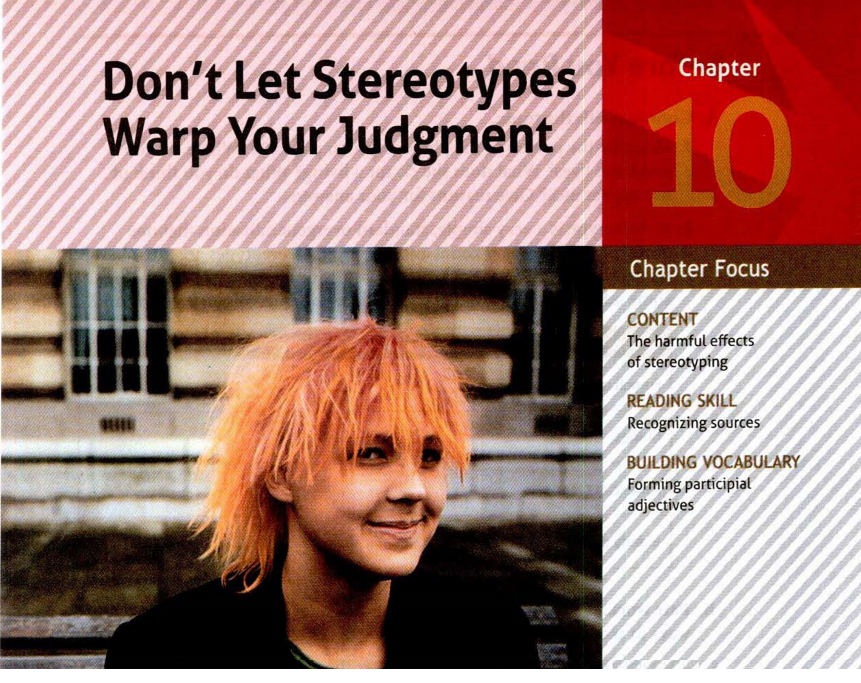
Don't Let Stereotypes Warp Your Judgment by Robert Heilbroner from Think Magazine
اجازه ندهید کلیشه ها قضاوت شما را منحرف کنند. نوشته شده توسط رابرت هیلبرونر از مجله فکر
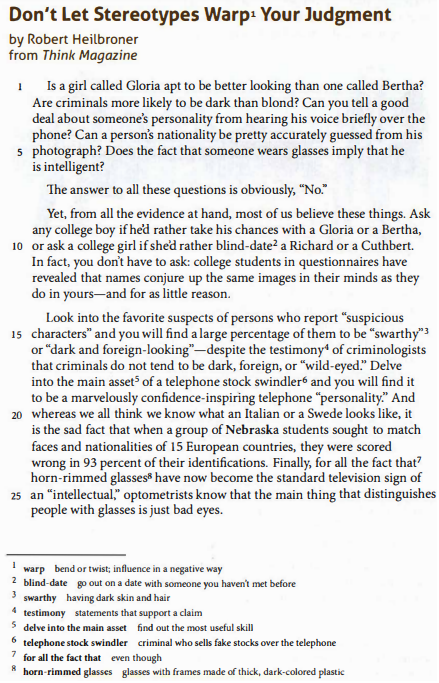
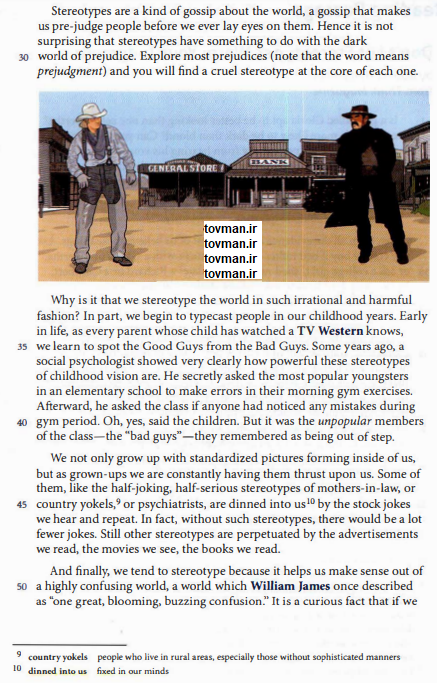
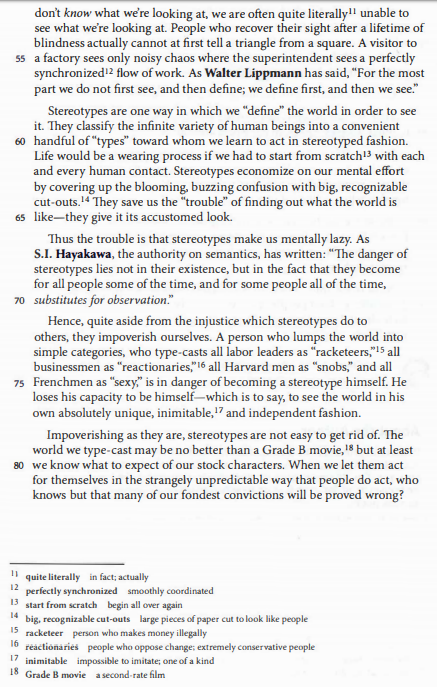
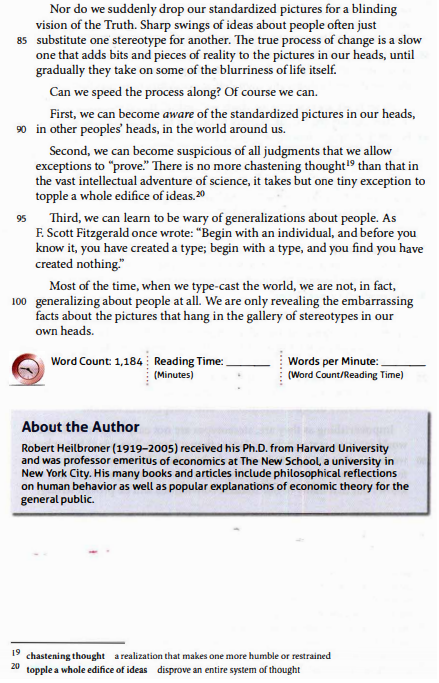
Is a girl called Gloria apt to be better looking than one called Bertha? Are criminals more likely to be dark than blond? Can you tell a good deal about someone's personality from hearing his voice briefly over the phone? Can a person's nationality be pretty accurately guessed from his photograph? Does the fact that someone wears glasses imply that he is intelligent?
آیا دختری با نام گلوریا بهتر از دختری با نام برتا به نظر می رسد؟ آیا بیشتر مجرمان سیاه هستند تا بور؟ آیا شما می توانید با شنیدن صدای کسی از پشت تلفن به طور خلاصه، تا حد خوبی در مورد شخصیتش صحبت کنید؟ آیا می توان تابعیت یک فرد را از عکسش حدس زد؟ آیا این واقعیت دارد شخصی که عینک می زند باهوش است؟
The answer to all these questions is obviously, "No:' Yet, from all the evidence at hand, most of us believe these things. Ask any college boy if he'd rather take his chances with a Gloria or a Bertha,or ask a college girl if she'd rather blind-date a Richard or a Cuthbert. In fact, you don't have to ask: college students in questionnaires have revealed that names conjure up the same images in their minds as they do in yours-and for as little reason
پاسخ همه این سوالات واضح است، نه. با این حال از روی شواهد موجود، اکثر ما به این چیزها اعتقاد داریم. از هر پسر دانشجوئی بپرسید که ترجیح می دهد، شانس خود را با دختری با نام گلوریا امتحان کند یا برتا؛ یا از یک دختر دانشجو بپرسید قرار ملاقات با پسری که قبلا نمی شناسد با اسم ریچارد را ترجیح می دهد یا کاتبرت. در حقیقت نیازی به پرسش نیست: دانشجویان در پرسشنامه ها نشان داده اند، اسامی همان تصاویری را به یاد شما می آورد که در ذهن شماست- به همان دلایل کوچک.
Look into the favorite suspects of persons who report "suspicious characters" and you will find a large percentage of them to be "swarthy" or "dark and foreign-looking" -despite the testimony of criminologists that criminals do not tend to be dark, foreign, or "wild-eyed:' Delve into the main asset of a telephone stock swindler۶ and you will find it to be a marvelously confidence-inspirmg telephone "personality:'
به مظنونان مورد علاقه کسانی که شخصیتهای مشکوک را گزارش می دهند، نگاه کنید و می بینید که درصد زیادی از آنها سبزه رو، سیاه و ظاهری خارجی دارند- برخلاف شهادت جرم شناسان که مجرمان متمایل به سیاه، خارجی بودن یا چشمان خیره از ترس نیستند. بدانید که مفیدترین مهارت کسانی که جنس های تقلبی را به صورت تلفنی می فروشند، این است که شخصیت الهام بخش و با اعتماد بنفسی عجیبی دارند.
And whereas we all think we know what an Italian or a Swede looks like, it is the sad fact that when a group of Nebraska students sought to match faces and nationalities of ۱۵ European countries, they were scored wrong in ۹۳ percent of their identifications. Finally, for all the fact that horn-rimmed glasses have now become the standard television sign of an "intellectual;' optometrists know that the main thing that distinguishes people with glasses is just bad eyes
درحالیکه همه ما فکر می کنیم که می دانیم یک ایتالیائی یا یک سوئدی چه شکلی هستند، این واقعیت غم انگیز است که زمانیکه یک گروه از دانشجویان نبراسکا به دنبال مطابقت چهره ها و ملیت های ۱۵ کشور اروپایی بودند، در ۹۳ درصد از شناسائی ها، اشتباه کردند. درنهایت با اینکه عینک های با قاب پلاستیکی شبیه شاخ به نشانه استاندارد روشنفکری تبدیل شده اند؛ عینک سازان می دانند که عمده ترین چیزی که افراد عینکی را متمایز می کند، فقط چشم های معیوب است.
Stereotypes are a kind of gossip about the world, a gossip that makes us pre-judge people before we ever lay eyes on them. Hence it is not surprising that stereotypes have something to do with the dark world of prejudice. Explore most prejudices (note that the word means prejudgment) and you will find a cruel stereotype at the core of each one
کلیشه ها نوعی شایعات در مورد جهان است ، شایعاتی که باعث می شود قبل از اینکه حتی نگاهی به مردم انداخته باشیم، آنها را داوری کنیم. از این رو جای تعجب ندارد که کلیشه ها ارتباطی با دنیای تاریک تعصبات دارند. اکثر تعصبات را کاوش کنید (توجه داشته باشید که این کلمه به معنای پیش داوری است) و کلیشه ای بی رحمانه در هسته هر یک پیدا خواهید کرد.
Why is it that we stereotype the world in such irrational and harmful fashion? In part, we begin to typecast people in our childhood years. Early in life, as every parent whose child has watched a TV Western knows, we learn to spot the Good Guys from the Bad Guys. Some years ago, a social psychologist showed very clearly how powerful these stereotypes of childhood vision are. He secretly asked the most popular youngsters in an elementary school to make errors in their morning gym exercises. Afterward, he asked the class if anyone had noticed any mistakes during gym period. Oh, yes, said the children. But it was the unpopular members of the class-the "bad guys-they remembered as being out of step
چرا ما جهان را با چنین روش غیرمنطقی و مضری کلیشه ای می کنیم؟ تا حدودی ما در سال های کودکی شروع به دادن نقش های یکسانی به آدم های خاصی می کنیم. در اوایل زندگی، هر والدینی که فرزند دارد و فیلم های وسترن تلوزیون را تماشا کرده است، می داند ما یاد می گیریم که افراد بد را از افراد خوب تشخیص دهیم. چند سال پیش یک روانشناس اجتماعی بطور واضح توضیح داد که این کلیشه های بینایی کودکی چقدر قدرتمند هستند. او از محبوب ترین نوجوانان در یک مدرسه ابتدایی خواست که در انجام تمرینات ورزش صبحگاهی مرتکب اشتباه شوند. پس از آن او در کلاس پرسید که آیا کسی متوجه اشتباهی در طول ورزش شده است. بچه ها گفتند بله. اما اعضای منفور کلاس بودند- بچه بدها- به یاد می آوردند که آنها هماهنگ نبودند.
We not only grow up with standardized pictures forming inside of us, but as grown-ups we are constantly having them thrust upon us. Some of them, like the half-joking, half-serious stereotypes of mothers-in-law, or country yokels, or psychiatrists, are dinned into us۱ by the stock jokes we hear and repeat. In fact, without such stereotypes, there would be a lot fewer jokes. Still other stereotypes are perpetuated by the advertisements we read, the movies we see, the books we read
ما نه تنها با تصاویر استاندارد شده ای که درون ما شکل می گیرد، بزرگ می شویم، بلکه به عنوان بزرگسال، بطور مداوم خود را مجبور می کنیم که آنها را تجربه کنیم. بعضی از آنها همانند جوک های کلیشه های با ظاهر شوخی و باطن جدی در مورد مادر شوهرها، یا روستائی ها یا روانشناسان با شنیدن و تکرار در ذهن ما نهادینه می شوند. در حقیقت، بدون چنین کلیشه هایی، شوخی های کمتری به وجود می آیند. کلیشه های دیگر، با تبلیغاتی که می خوانیم، فیلمهایی که می بینیم، کتابهایی که می خوانیم، ماندگار شده اند.
And finally, we tend to stereotype because it helps us make sense out of so a highly confusing world, a world which William James once described as "one great, blooming, buzzing confusion;' It is a curious fact that if we don't know what we're looking at, we are often quite literally unable to see what we're looking at. People who recover their sight after a lifetime of blindness actually cannot at first tell a triangle from a square. A visitor to a factory sees only noisy chaos where the superintendent sees a perfectly synchronized flow of work. As Walter Lippmann has said, "For the most part we do not first see, and then define; we define first, and then we see
و بالاخره ما تمایل به کلیشه داریم زیرا به ما کمک می کند تا یک دنیای بسیار گیج کننده را به روشی که بتوانیم بفهمیم، درک کنیم. جهانی که زمانی ویلیام جیمز آن را یک سردرگمی وزوز کننده، کامل و عالی توصیف کرد. این یک واقعیت عجیب است که اگر ما ندانیم به چه چیزی نگاه می کنیم، به معنای واقعی کلمه قادر نیستیم آنچه را که نگاه می کنیم، ببینیم.
People who recover their sight after a lifetime of blindness actually cannot at first tell a triangle from a square. A visitor to a factory sees only noisy chaos where the superintendent sees a perfectly synchronized flow of work. As Walter Lippmann has said, "For the most part we do not first see, and then define; we define first, and then we see
افرادی که بعد از یک عمر کوری، بینایی خود را باز می یابند، حقیقتاً در ابتدا قادر نیستند یک مثلث را از مربع تشخیص دهند. یک بازدید کننده از یک کارخانه، تنها هرج و مرج پر سر و صدا را می بیند، در حالیکه یک سرپرست، یک جریان کاملاً هماهنگ کاری را می بیند. همانطور که والتر لیمپن گفته است؛ در اکثر موارد ما ابتدا نمی بینیم و سپس می شناسیم؛ ما ابتدا می شناسیم و سپس می بینیم.
Stereotypes are one way in which we "define" the world in order to see it.They classify the infinite variety of human beings into a convenient handful of "types" toward whom we learn to act in stereotyped fashion. Life would be a wearing process if we had to start from scratch with each and every human contact. Stereotypes economize on our mental effort by covering up the blooming, buzzing confusion with big, recognizable cut-outs They save us the "trouble" of finding out what the world is like-they give it its accustomed look
کلیشه ها راهی هستند که با آن جهان را تعریف می کنیم تا آن را ببینیم. آنها موجودات انسانی بی نهایت متفاوت را به تعدادی انواع ساده طبقه بندی می کنند تا یاد بگیریم به سبک کلیشه ای عمل کنیم. اگر ما مجبور باشیم با هر تماس انسانی همه چیز را از نو شروع کنیم، زندگی فرایندی فرسایشی خواهد بود. کلیشه ها با پوشاندن سردرگمی وزوز کننده کامل با تکه های بزرگی از کاغذ برش خورده که شبیه مردم است، در تلاش های ذهنی ما صرفه جویی می کنند. آنها ما را از زحمت فهمیدن اینکه دنیا چطور است نجات می دهند- آنها به آن، ظاهر همیشگی خودش را می دهند.
Thus the trouble is that stereotypes make us mentally lazy. As S.I. Hayakawa, the authority on semantics, has written: The danger of stereotypes lies not in their existence, but in the fact that they become for all people some of the time, and for some people all of the time, substitutes for observation
مشکل این است که کلیشه ها ما را از لحاظ ذهنی تنبل می کنند. همانطور که اس ال هایاکاوا مرجع معنی شناسی نوشته است: خطر کلیشه ها نه در وجود آنها نهفته است بلکه خطر آنها در این واقعیت است که برای همه مردم، بعضی اوقات و برای برخی مردم همه اوقات؛ جایگزین مشاهده می شوند.
Hence, quite aside from the injustice which stereotypes do to others, they impoverish ourselves. A person who lumps the world into simple categories, who type-casts all labor leaders as "racketeers; all businessmen as "reactionaries: all Harvard men as "snobs;' and all Frenchmen as "sexy;' is in danger of becoming a stereotype-himself. He loses his capacity to be himself-which is to say, to see the world in his own absolutely unique, inimitable, and independent fashion
از این رو، جدا از بی عدالتی که کلیشه ها با دیگران می کنند، خودمان را بی خاصیت می کند. شخصی که جهان را در مقولات ساده ای قرار می دهد، و همه رهبران کارگری را در قالب شیاد، همه تجار را در قالب مرتجع، همه مردان هاروارد را در قالب خودپسند و همه مردان فرانسوی را در قالب سکسی قرار می دهد، در خطر تبدیل شدن به یک کلیشه است. او ظرفیت خود را برای اینکه خودش باشد از دست می دهد- که بگوید جهان را با روشی کاملاً بی نظیر، غیرقابل تقلید و به روشی مستقل ببینید.
Impoverishing as they are, stereotypes are not easy to get rid of. The world we type-cast may be no better than a Grade B movie, but at least we know what to expect of our stock characters. When we let them act for themselves in the strangely unpredictable way that people do act, who knows but that many of our fondest convictions will be proved wrong?
همانند فقیر شدن، از دست کلیشه ها هم به سادگی نمی توان خلاص شد. دنیایی که ما آن را بازی کرده ایم ممکن است بهتر از یک فیلم درجه دو نباشد، اما حداقل می دانیم از شخصیت موجود ما چه انتظاری دارند. هنگامیکه به آنها اجازه می دهیم برای خودشان به روشی عجیب و غیر قابل پیش بینی همانند مردم عمل کنند، چه کسی می داند، شاید بسیاری از عقایدی که با آنها انس گرفته ایم اشتباه باشند؟
Nor do we suddenly drop our standardized pictures for a blinding vision of the Truth. Sharp swings of ideas about people often just substitute one· stereotype for another. The true process of change is a slow one that adds bits and pieces of reality to the pictures in our heads, until gradually they take on some of the blurriness of life itself.
ما به طور ناگهانی تصاویر استاندارد شده را برای بینش درخشانی از حقیقت رها نمی کنیم. نوسانات تند و تیز ایده ها در مورد مردم، اغلب فقط یک کلیشه را جایگزین کلیشه دیگر می کند. روند واقعی تغییر کند است که ذره ها و بخش های واقعیت را به تصاویر ذهن ما اضافه می کند تا آنها برخی از ابهامات زندگی خود را بردارند.
Can we speed the process along? Of course we can. First, we can become aware of the standardized pictures in our heads, in other peoples' heads, in the world around us.
آیا می توانیم این روند را به سرعت طی کنیم؟ البته که می توانیم. اول ، ما می توانیم از تصاویر استاندارد در سر خود، در سر دیگر افراد، در دنیای اطراف خود آگاه شویم.
Second, we can become suspicious of all judgments that we allow exceptions to "prove:' There is no more chastening thought۱۹ than that in the vast intellectual adventure of science, it takes but one tiny exception to topple a whole edifice of ideas
دوماً ما می توانیم به همه قضاوت های که بطور استثناء اجازه می دهیم اثبات شوند، شک کنیم: دیگر درکی که فردی را محدود و زبون کند وجود ندارد که در ماجرای وسیع فکری علوم، تنها با یک استثناء کوچک، عمارت ایده ها فرو ریزد.
Third, we can learn to be wary of generalizations about people. As F. Scott Fitzgerald once wrote: "Begin with an individual, and before you know it, you have created a type; begin with a type, and you find you have created nothing
سوم ، ما می توانیم یاد بگیریم که نسبت به تعمیم در مورد مردم احتیاط کنید. همانطور که اف. اسکات فیزتگرالد سابقاً نوشت: "با یک فرد شروع کنید، و قبل از اینکه آن را بشناسید، یک نوع ایجاد کرده اید؛ از یک نوع شروع کنید ، و در می یابید که هیچ چیزی ایجاد نکرده اید.
Most of the time, when we type-cast the world, we are not, in fact, generalizing about people at all. We are only revealing the embarrassing facts about the pictures that hang in the gallery of stereotypes in our own heads.
بیشتر اوقات ، وقتی جهان را در قالب خاصی می گذاریم، در حقیقت به طور کلی در مورد مردم تعمیم نداریم. ما فقط واقعیتهای شرم آور را درباره عکسهایی که در گالری کلیشه ها در ذهن خودمان آویزان است، آشکار می کنیم.

